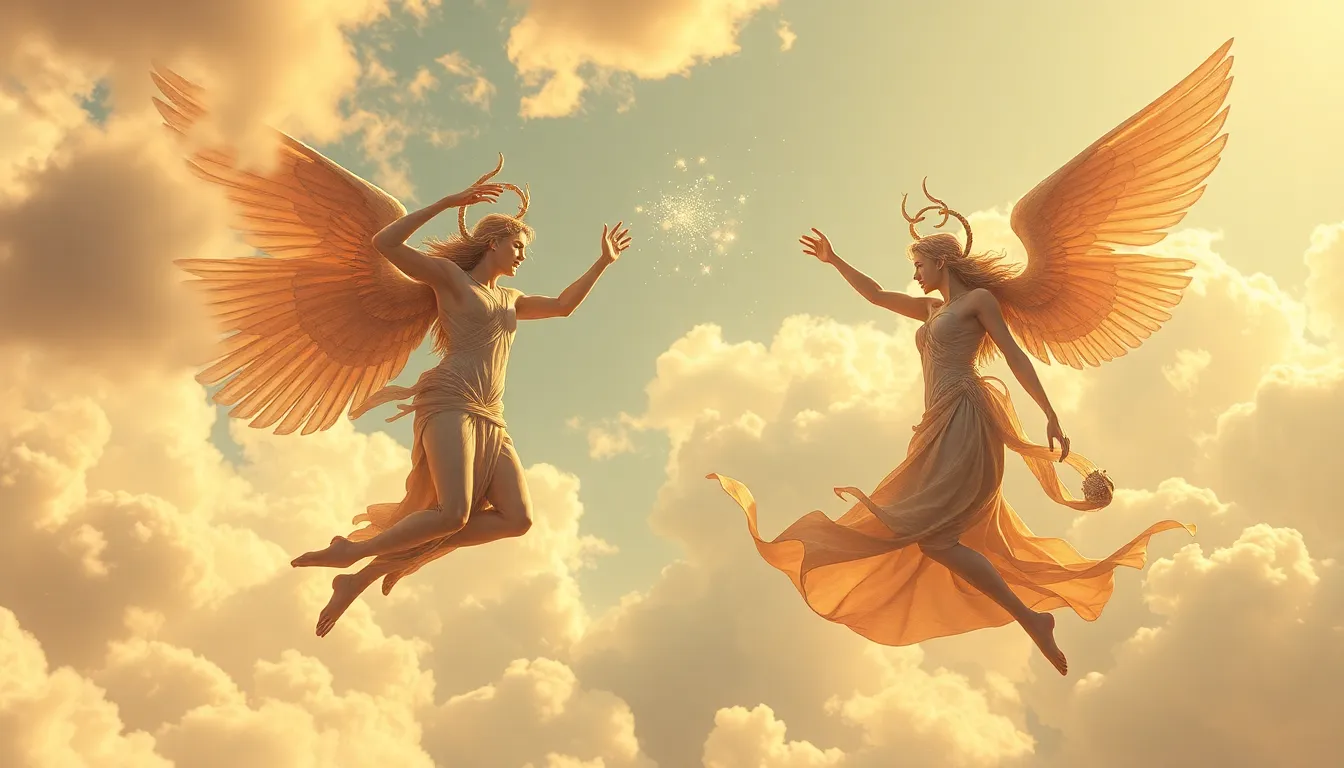The Nymphs of the Sky: Exploring the Role of Aetherial Spirits
I. Introduction to Aetherial Spirits
Aetherial spirits, often referred to as nymphs or elemental beings, are mythological entities associated with the upper realms of the Earth, particularly the sky. These spirits are believed to embody the essence of the heavens and play a significant role in various mythologies around the world.
The concept of aetherial spirits has its roots in ancient civilizations, where they were revered as divine manifestations of nature and the cosmos. They were often seen as mediators between the gods and humanity, embodying the beauty and mystery of the sky.
This article delves into the fascinating world of sky nymphs, exploring their mythological backgrounds, characteristics, and enduring influence on art, culture, and spirituality.
II. Mythological Background of Sky Nymphs
Sky nymphs are prevalent in ancient myths and legends, often depicted as ethereal beings who inhabit the skies. They were believed to control various aspects of the weather, such as rain, wind, and storms, and were associated with different celestial bodies.
- Greek Mythology: In Greek mythology, the Aether was personified as a primordial deity, often associated with the upper air and light. The Nereids and Oceanids, although primarily sea nymphs, also had sky-related counterparts.
- Roman Mythology: Roman culture inherited many aspects of Greek mythology, with aetherial spirits like the Aurae, the personifications of breezes, taking on significant roles.
- Other Cultures: Various cultures have their own interpretations of sky nymphs. For instance, the Native American tribes often spoke of sky spirits that influenced weather patterns and agricultural cycles.
III. Characteristics and Attributes of Sky Nymphs
Sky nymphs are often depicted with distinct physical characteristics that reflect their ethereal nature. Artists and storytellers have portrayed them in various ways:
- Physical Depictions: Sky nymphs are frequently illustrated as beautiful women adorned with flowing garments that mimic the clouds or celestial bodies. They are often depicted with wings, symbolizing their ability to traverse the skies.
- Symbolic Meanings: These spirits are associated with elements such as air, light, and the weather. They symbolize freedom, inspiration, and the transient nature of beauty.
- Roles in Mythology: Sky nymphs serve multiple roles, including guardians of the heavens, muses for artists and poets, and symbols of love and desire. They often inspire human creativity and serve as protectors of the natural world.
IV. Aetherial Spirits in Literature and Folklore
Throughout history, sky nymphs have been featured prominently in literature and folklore, often symbolizing the intersection of the divine and the earthly.
- Notable Works: Classic texts such as Homer’s “The Iliad” and “The Odyssey” include references to aetherial spirits. Additionally, works from the Romantic period, such as those by Keats and Shelley, often explore themes of nature and the divine through the lens of sky nymphs.
- Storytelling Themes: In many narratives, sky nymphs embody themes of love, loss, and the quest for transcendence. Their interactions with mortals often serve as pivotal moments in the story, revealing deeper truths about the human condition.
- Modern Adaptations: Contemporary literature and media continue to reinterpret these ancient beings, often portraying them in fantasy genres that explore their magical and ethereal qualities.
V. The Influence of Sky Nymphs on Art and Culture
The allure of sky nymphs has inspired countless artistic movements and cultural expressions throughout history.
- Artistic Movements: The Symbolist and Romantic movements celebrated the beauty and mystery of nature, often featuring sky nymphs as central figures in their artworks.
- Visual Arts: Famous paintings, such as those by artists like John William Waterhouse and Gustave Moreau, depict sky nymphs in dreamy and ethereal settings, capturing their essence as beings of beauty and grace.
- Contemporary Media: Sky nymphs continue to appear in films, music videos, and literature, often representing themes of freedom and connection to nature.
VI. Spiritual Beliefs and Practices Involving Sky Nymphs
Sky nymphs have also played a role in various spiritual beliefs and practices, both in ancient times and in modern neo-pagan movements.
- Rituals and Customs: In ancient cultures, rituals were held to honor aetherial spirits, often involving offerings or prayers to ensure favorable weather and bountiful harvests.
- Contemporary Movements: Many modern spiritual practices, particularly within neo-paganism, incorporate the reverence of sky nymphs as part of their belief systems, celebrating their connection to nature and the cosmos.
- Personal Experiences: Many individuals report personal connections or experiences with sky nymphs, feeling their presence during moments of inspiration or in the beauty of nature.
VII. The Relevance of Aetherial Spirits Today
As we navigate the complexities of modern life, the lessons and symbolism of aetherial spirits remain relevant.
- Environmental Themes: The connection between sky nymphs and nature emphasizes the importance of environmental stewardship and the need to protect our planet.
- Lessons from Mythology: The stories of sky nymphs teach us about the balance between humanity and nature, urging us to seek harmony in our lives.
- Mindfulness and Spirituality: Engaging with the mythology of sky nymphs can promote a sense of mindfulness, encouraging individuals to appreciate the beauty of the world around them.
VIII. Conclusion: The Enduring Legacy of Sky Nymphs
The legacy of sky nymphs endures through the ages, captivating our imagination and inspiring creativity. Their roles in mythology, art, and spirituality remind us of the beauty and mystery of the natural world.
As we reflect on the key points discussed in this article, it becomes clear that aetherial spirits hold a timeless fascination that transcends cultures and generations.
In a world increasingly disconnected from nature, we are called to explore and appreciate the mystical elements around us, perhaps finding our own connection to the sky nymphs that once inspired the ancients.




